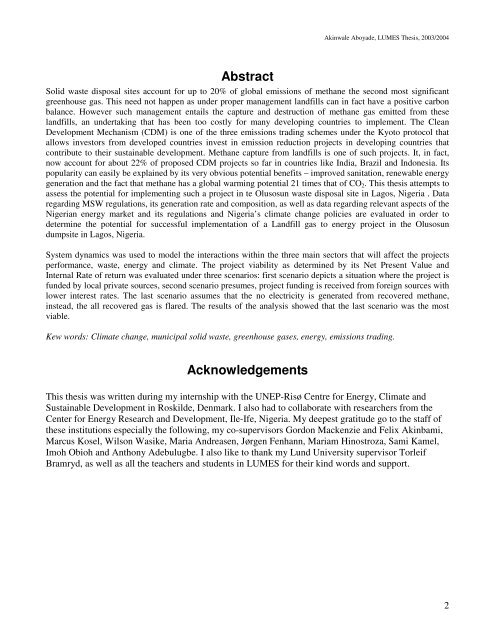Wale Aboyade's thesis - lumes
Wale Aboyade's thesis - lumes
Wale Aboyade's thesis - lumes
You also want an ePaper? Increase the reach of your titles
YUMPU automatically turns print PDFs into web optimized ePapers that Google loves.
Akinwale Aboyade, LUMES Thesis, 2003/2004<br />
Abstract<br />
Solid waste disposal sites account for up to 20% of global emissions of methane the second most significant<br />
greenhouse gas. This need not happen as under proper management landfills can in fact have a positive carbon<br />
balance. However such management entails the capture and destruction of methane gas emitted from these<br />
landfills, an undertaking that has been too costly for many developing countries to implement. The Clean<br />
Development Mechanism (CDM) is one of the three emissions trading schemes under the Kyoto protocol that<br />
allows investors from developed countries invest in emission reduction projects in developing countries that<br />
contribute to their sustainable development. Methane capture from landfills is one of such projects. It, in fact,<br />
now account for about 22% of proposed CDM projects so far in countries like India, Brazil and Indonesia. Its<br />
popularity can easily be explained by its very obvious potential benefits – improved sanitation, renewable energy<br />
generation and the fact that methane has a global warming potential 21 times that of CO 2 . This <strong>thesis</strong> attempts to<br />
assess the potential for implementing such a project in te Olusosun waste disposal site in Lagos, Nigeria . Data<br />
regarding MSW regulations, its generation rate and composition, as well as data regarding relevant aspects of the<br />
Nigerian energy market and its regulations and Nigeria’s climate change policies are evaluated in order to<br />
determine the potential for successful implementation of a Landfill gas to energy project in the Olusosun<br />
dumpsite in Lagos, Nigeria.<br />
System dynamics was used to model the interactions within the three main sectors that will affect the projects<br />
performance, waste, energy and climate. The project viability as determined by its Net Present Value and<br />
Internal Rate of return was evaluated under three scenarios: first scenario depicts a situation where the project is<br />
funded by local private sources, second scenario presumes, project funding is received from foreign sources with<br />
lower interest rates. The last scenario assumes that the no electricity is generated from recovered methane,<br />
instead, the all recovered gas is flared. The results of the analysis showed that the last scenario was the most<br />
viable.<br />
Kew words: Climate change, municipal solid waste, greenhouse gases, energy, emissions trading.<br />
Acknowledgements<br />
This <strong>thesis</strong> was written during my internship with the UNEP-Risø Centre for Energy, Climate and<br />
Sustainable Development in Roskilde, Denmark. I also had to collaborate with researchers from the<br />
Center for Energy Research and Development, Ile-Ife, Nigeria. My deepest gratitude go to the staff of<br />
these institutions especially the following, my co-supervisors Gordon Mackenzie and Felix Akinbami,<br />
Marcus Kosel, Wilson Wasike, Maria Andreasen, Jørgen Fenhann, Mariam Hinostroza, Sami Kamel,<br />
Imoh Obioh and Anthony Adebulugbe. I also like to thank my Lund University supervisor Torleif<br />
Bramryd, as well as all the teachers and students in LUMES for their kind words and support.<br />
2

















